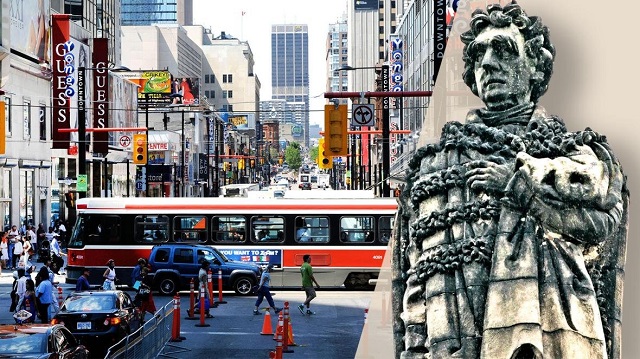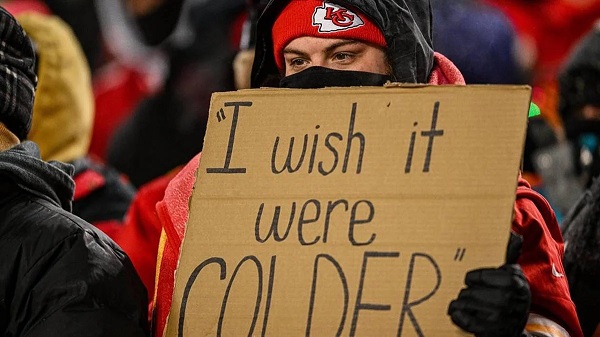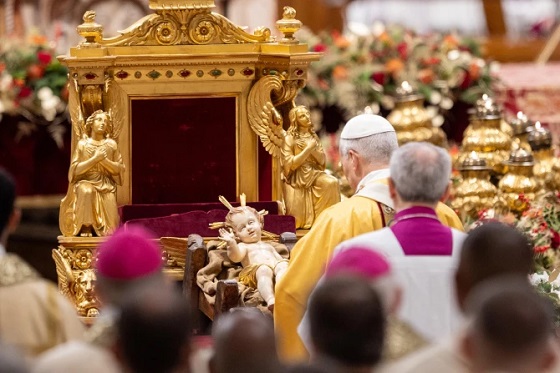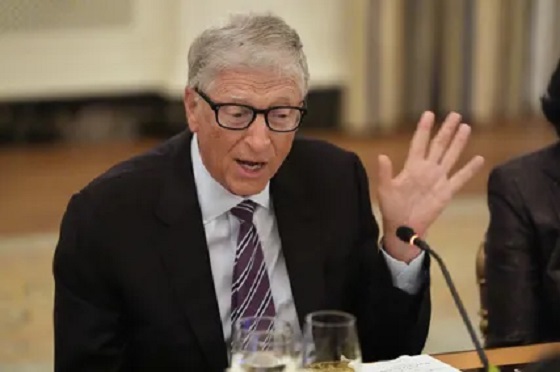Bruce Dowbiggin
Dead-End Streets & Empty Graves: Faking The Past

The problem with history is that you can attach your name to passing fads— say, Ukraine flag emojis— and be considered one of the cool kids. For a while. But eventually truth catches up with you. (Just ask Joe Biden.) And if you cannot defend your attachment to banning Dundas Street or calling Canada genocidal you will eventually find yourself on the wrong side of history, mocked, disparaged and rightfully ignored by future generations.
If you are Stalin or Mao in such a bind you simply shoot everyone who points out your gross inaccuracies. But if you live in a less blood-soaked tyranny, you’d better be prepared to face your critics.
Which brings us to the virtuous folks at Toronto City Hall who want to remove the name of Scotsman Henry Dundas, 1st Viscount Melville, from the 23-kilometre stretch from Mississauga to Scarborough that bears his name. In the same rush of blood to the head that saw radicals change the name of Ryerson University to the Anodyne School of Nothingness, these crack researchers decided Dundas was an active proponent of slavery in the eighteenth/nineteenth centuries.

The proposal they’ve presented to Toronto City Council would cost (their estimate) $8.1 M to remove his name from the endless street. This at a time when the Gardiner Expressway is set to collapse. And city parks are filled with drug addicts and mental health patients. And getting a building permit is only slightly less difficult than the Egyptians creating the pyramids. Priorities!
But we digress. The cost to every person, business or church located on that span or to those doing business with, sending a parcel to or planning a transit trip on Dundas dwarfs that estimate. But Wokeness must be served. Dundas had tried to prevent the anti-slavery forces in England from banning the practice universal in the world at the time. Smart guys say so.
Now—saints preserve us— three former Toronto mayors beg to disagree. They’ve actually read the history of Dundas that the civil servants misrepresented, and they want new lefty mayor Olivia Chow to stop the Dundas Street purge. Turns out Dundas was a LEADER in ending slavery in the British empire, after all. Oops.

For media slappies— you know who you are— who embraced the demise of Dundas much as they embraced the defrocking of Egerton Ryerson, Joseph Brant and Sir John A. this creates whiplash. How to stay onside with the real history after going balls-deep on the slavery devil narrative?
The easy answer is to— look at that shiny object— refer to the handy list of other street names still to be banned by city hall. Yonge Street. Wellesley Street. Simcoe Street. Even Baby Point Road. Go hard on them. Sure, you’ll run out of tyrants and racists eventually, but by then everyone will have forgotten how you libeled Dundas and Sir John A.

A similar rethink is also underway in regards to the “Mass graves/ Genocidal Canada” story promoted by PMJT. You remember? Skippy clutching a teddy bear in a Kamloops cemetery that was rumored to contain the graves of children who met a bad end in the care of the Church or residential school? Then cancelling Canada Day and leaving flags at half mast for months. And telling the UN that Canada is genocidal, because x-rays showed what could have been dead babies underground. Or just rocks.
Forget that no parent of a Rez school child had ever reported a child missing or alleged murder or exorcism, the PM cast his lot with the murder meme. In several cases Trudeau was told by chiefs that the locals knew precisely who was buried in those graves. Cowessess First Nation band member Irene Andreas . “There is no ‘discovery’ of graves. We buried our dead with a proper funeral. Then we allowed them to Rest In Peace…To assume that foul play took place would be premature and unsupported… So please, people, do not make up stories about residential school children being put in unmarked graves. No such thing ever happened.”

Trudeau was unrepentant. It was Teddy bear or bust. As we wrote in June, the narrative was furthered by the absence of any exhumed graves. Critics— labelled as deniers— were forced to disprove the story. Former Indigenous Affairs Minister Marc Miller described as “ghouls” those who pointed out that residential school indigenous children died of the diseases of the day. As a few brave souls discovered, crossing Miller was a ticket to non-person status.
Until now. Turns out that Brandon University excavators examined a site under a Manitoba church identified as problematic by x-ray. The ground search cited 57 abnormalities. Their finding? Nope. Just rocks.
Which should be good news. Except if, like Trudeau’s chum Miller, you’re invested in Justin’s Genocidal narrative. Then it’s very bad. Pine Creek nation chief Derek Nepinak took great pains in announcing the discovery to stress, like Yosemite Sam, that I-don’t-know-how-they-done-it, but-I-know-they-done- it.

Nepinak’s preamble: “As a community we were preparing for more than one possible outcome, which meant we would prepare for the worst but hope for the best.” This suggested no remains was a positive. https://nationalpost.com/news/canada/excavation-after-14-anomalies-detected-at-former-residential-school-site-found-no-evidence-of-graves-manitoba-chief
Guess again. “The results of our excavation under the church should not be deemed as conclusive of other ongoing searches and efforts to identify reflections from other community processes including other (ground-penetrating radar) initiatives… “This does not mark the end of our truth-finding project.”
No kidding. Except the very limited excavations done so far have revealed none of the alleged murdered children so desperately conjured up by the Trudeau media and the radicals in the Indigenous community. Barring forensic evidence we are left with stories from elders and the lurid tales at the reconciliation committee.
That standard may be fine for the Indigenous community, but in the outside world those journalists who described scenes of horror and Canada’s role in it should disappear for a while. Fat chance. That would include David Butt, a Toronto criminal lawyer writing in the Globe and Mail, claiming “The discovery of thousands of unmarked graves of Indigenous children on the sites of former residential schools…looks and smells like criminal activity.”
Activist firebrand Robert Jago said anyone questioning the validity of his own genocide allegations should be considered equivalent to “Holocaust denial” and punished as a hate-speech purveyor. And then there’s Trudeau cabinet hacks like Miller echoing The Boss.
So don’t expect a reckoning. There are truths, and then there are truths. As former CRTC vice chair Peter Menzies observed: “The one thing this process has made abundantly clear is that the interests of anyone outside their club are irrelevant to all inside it.”
Sign up today for Not The Public Broadcaster newsletters. Hot takes/ cool slants on sports and current affairs. Have the latest columns delivered to your mail box. Tell your friends to join, too. Always provocative, always independent. https://share.hsforms.com/16edbhhC3TTKg6jAaRyP7rActsj5
Bruce Dowbiggin @dowbboy is the editor of Not The Public Broadcaster A two-time winner of the Gemini Award as Canada’s top television sports broadcaster, he’s a regular contributor to Sirius XM Canada Talks Ch. 167. Inexact Science: The Six Most Compelling Draft Years In NHL History, his new book with his son Evan, was voted the seventh-best professional hockey book of all time by bookauthority.org . His 2004 book Money Players was voted sixth best on the same list, and is available via http://brucedowbigginbooks.ca/book-personalaccount.aspx
Bruce Dowbiggin
Hunting Poilievre Covers For Upcoming Demographic Collapse After Boomers

For those not familiar with hunting seasons in Canada it may come as a surprise that the nation has a year-round hunting season. That would be the targeting of Conservative leader Pierre Poilievre by the massed army of Liberals, their bots and the richly endowed media pack. Forget he’s never held power. He’s to blame for the ills in Canadian society.
It has been a good hunt. After floor-crossing by dissident CPC, the Liberals are one seat from the majority that Canadian voters denied them in the spring. (They’ll likely get the majority soon.) MPs who a day earlier were at Conservative Xmas parties suddenly sang the praises of Carney. MPs in ridings targeted by the Chinese suddenly joined Team Elbow Up.
All the while the media corps landed blows from their perch. Robert Benzie: “I know that Premier [Danielle] Smith is very unhappy privately with Pierre Poilievre because she thinks that [MOU motion] is undermining this [pipeline] project.” The nadir of the media dog pile was formerly eminent scribe Robert Fife who sniped, “Conservatives persist with cute legislative tricks, while the government tries to run a country.” Run a country. That’s rich.
From his lips to Liberal brains, however. “.@CBCNews and @AlJazeeraWorld viewers consider themselves uniquely informed, says @ElectionsCan_E report. The two TV networks were named by self-described “informed” voters when asked where they got their news. “
It is, seemingly, a great time to be a Liberal. Or not. While Operation Poilievre was gathering steam for Xmas polling revealed that Liberals and Conservatives remain locked in a tie, and Canadians continue to express ambivalence about the country’s direction, mixed feelings about their leaders, and sharp divides by generation, region, and policy concern. These generational discrepancies continue to be buried.

As was the case in the spring, the Liberals are supported only by the Boomer generation that swallowed Elbows Up nostalgia like a fat man on a donut. The under 60s demo at every level shows the current Carney agenda is a loser for them. In the segment of house-rich Boomers the Libs lead 50-31 over CPC. But in every other category it’s “how can I get out of here faster?”
The 45-59 demo it’s 46-36 Conservatives; 30-44 it’s a whopping 48-31 CPC; 18-29 it’s 40-39 CPC. A healthy chunk of Liberal supporting from the collapse of NDP vote. Where they used to poll in the 20s, the highest demo shows 11 percent support. Otherwise Poilievere would be PM.
Meanwhile, research now finds that 54 percent of Canadians say the growing number of newcomers to the country threatens our traditional customs and values— an increase of sixteen points since 2020. Over the same period, the share of Canadians who say immigration strengthens our society fell thirteen points to 35%
In short, the Carney Circus of marrying Canada to China and the EU is a card trick that will be exposed shortly. But where do we see the Ottawa press corps attention to this impending demographic snow plow? As we wrote in March “It’s not hard to see the (under 60s) looking at the Mike Myers obsession with a long-gone Canada and saying let’s get out of here.
Recently former TVOntario host Steve Pakin attended two convocations. The first at the former Ryerson University, (switched to Toronto Metropolitan University in a fit of settler colonizer guilt.) The second at Queens University, traditionally one of the elite schools in the nation. Here’s what he saw.
“At the end of the (TMU) convocation, when Charles Falzon, on his final day as dean of TMU’s Creative School, asked students to stand and sing the national anthem, many refused. They remained seated. Then, when the singing began, it was abundantly noticeable that almost none of the students sang along. And it wasn’t because they didn’t know the words, which were projected on a big screen. The unhappy looks on their faces clearly indicated a different, more political, explanation.
“I asked some of the TMU staff about it after the ceremony was over, and they confirmed what I saw happens all the time at convocations. Then I texted the president of another Ontario university who agreed: this is a common phenomenon among this generation at post-secondary institutions.”
At Queens, where Canadian flags were almost non-existent, O Canada was sung, but the message of unrest was clear: “Convocation sends a message of social stability,” Queen’s principal Patrick Deane began in his speech. “It is a ceremony shaped in history. You should value your connection to the past, but question that inheritance. Focus on the kind of society you’d like to inhabit.”
You can bet Deane is not telling them to question climate change and trans rights. As Paikin observes, “if we fail to create a more perfect union, we shouldn’t be surprised when a vast swath of young people don’t sing our anthem the way so many of the rest of us do.” So why are the best and brightest so reluctant to see as future in becoming the new professional class that runs society?
In the Free Press River Page searched the source of their discontent. “If the Great Recession, Covid-19, and the spectre of an artificial intelligence-assisted ‘white collar bloodbath’ has taught the professional class anything, it is that their credentials cannot save them. This insecurity, compounded by the outrageous cost of living in many large cities, has pushed the PMC’s anxieties to the breaking point.

“Add that to the triumph of identity politics in professional class institutions like universities, corporate C-suites, non-governmental organizations, and media—itself a byproduct of inter-elite competition as many have observed—and what you have is the modern left.
“… they’ve already come to the baffling conclusion that there’s no difference between class struggle and child sex changes. More to the point, the socialist mantra “From each according to his ability, to each according to his need” has only ever stood the test of time in Anabaptist sects. It requires a religious devotion to self-sacrifice that is not characteristic of this anxious and hyper-competitive class—as many actual socialists have spent the last decade warning.”
The tsunami over immigration has caused severe dislocations— as PM Steven Harper predicted in the 2015 election debate. He was shouted down by the dopey dauphin Justin Trudeau who opened the sluice gates to every kind of progressive nonsense. Which is now evident.
Like all people addicted, CDN Boomers don’t want the truth. They want performance theatre, T-shirts and hockey games. They blame Trump for their predicament, caught between grim realities. Will they take the 12 steps? Or will their kids have to tell them the facts as they escort them to the home?” We’re now seeing the likely answer to that question everywhere in Canadian society.
Bruce Dowbiggin @dowbboy is the editor of Not The Public Broadcaster A two-time winner of the Gemini Award as Canada’s top television sports broadcaster, his 2025 book Deal With It: The Trades That Stunned The NHL And Changed hockey is now available on Amazon. Inexact Science: The Six Most Compelling Draft Years In NHL History, his previous book with his son Evan, was voted the seventh-best professional hockey book of all time by bookauthority.org . His new poetry collection In Other Words is available via brucedowbigginbooks.ca and on Kindle books
Bruce Dowbiggin
NFL Ice Bowls Turn Down The Thermostat on Climate Change Hysteria

Oh, the weather outside was frightful. But the football was so delightful. Week 15 of the NFL season was a cryogenic success of snow and sub-zero temperatures. Here were the temperatures at game time this weekend.
Chicago: -11 degrees C.
Cincinnati: -12 degrees F.
Kansas City: -8 degrees C.
New England: -2 C (with an 87 percent chance of snow).
Philadelphia: -2 degrees C.
New York -1 degree C.
Pittsburgh: -7 degrees C.
For fans of NFL football none of this seemed out of character with late-season football. There are legendary games played in arctic conditions. The windchill for the 1967 Dallas/ Green Bay NFC championship was -25 C.
Chargers at Bengals: Jan. 10, 1982 (-24 C, feels like -39 C).
Seahawks at Vikings in NFC wild-card matchup Jan 10, 2016. -21 C with wind chill -25C
Dolphins at Chiefs: Jan. 13, 2024 (-4 degrees, feels like -27 degrees)
As recently as last week’s Bills win over the Bengals games are often played with drifts of snow on the field and the mercury bottoming out. While Canada’s Grey Cup game is played at the end of November it’s still had some brutal weather history of its own.
The point of this meteorology meandering is that, according to our good King Charles III and many other doomsday cultists the concept of snow and cold was supposed to be a figment of the past by now. For almost half a century Michael Mann and the climate prophets of IPCC have been predicting the end of snow and the onset of warmist floods and burning forests. They gambled trillions of the public’s dollars on the certainty that the public would buy computer modelling and data-distortion predicting doom.
For decades it has worked. The careers of people like critic Mark Steyn have been ruined, heretics declared and fortunes dissipated by the trust-fund fanatics who bankroll wackadoodles like Stephen Guilbeault, the convicted felon who Trudeau made Minister of the Environment. No matter how absurd or devious the source, it was a gospel that the fiery inferno was coming next Tuesday. But the weather has remained stubbornly resistant to Elizabeth May’s catechism of climate.

Yet, some dedicated climate advocates and their followers are finally changing their tune in the face of their own observation of lying liars like Al Gore and Greta Thunberg. The share of Americans who say climate scientists understand very well whether climate change is occurring decreased from 37 percent in 2021 to 32 percent this year. A similar October study from the University of Chicago’s Energy Policy Institute found that “belief in human-driven climate change declined overall” since 2017.
Reports the uber-liberal L.A. Times: “The unraveling of climate catastrophism got another jolt recently with the formal retraction of a high-profile 2024 study published in the journal Nature. That study — which had predicted a calamitous 62% decline in global economic output by 2100 if carbon emissions were not sufficiently reduced — was widely cited by transnational bodies and progressive political activists alike as justification for the pursuit of aggressive decarbonization.
But the authors withdrew the paper after peer reviewers discovered that flawed data had skewed the result. Without that data, the projected decline in output collapses to around 23%. Oops.”
Even stalwart media apologists for climate hysteria like the Times are starting to have doubts. Under the headline “The left’s climate panic is finally calming down” they describes “Erstwhile ardent climate-change evangelist Bill Gates published a remarkable blog post addressing climate leaders at the then-upcoming COP30 summit. Gates unloaded a blistering critique of what he called ‘the doomsday view of climate change,’ which he said is simply “wrong.”
Trump-besotted American Democrats seeking to soften their Woke image before the 2026 midterms are likewise carving out more moderate positions on climate “that could well deprive Republicans of a winning political issue with which to batter out-of-touch, climate-change-besotted Democrats. But for the sake of good governance, sound public policy and the prosperity of the median American citizen, it would be the best thing to happen in a decade.”
Sadly Canada under Mark Carney remains a staunch climate warrior. The removal of Guilbeault as federal Environmental Minister may have seemed a step toward sanity, but there is no hint that the billions of dollars from hidden money spigots will be closed down any time soon. The B.C. government’s acquiescence to the climate propaganda of Indigenous bands shows no sign of abating. Indeed, it is just ramping up in the land claims that threaten to make home ownership a thing of the past.

PM Mark Carney is a dedicated temperature fabulist going back to his days as governor of the Bank of England. His first fights in Canada were over taxing carbon and hobbling her energy industry. As we wrote in this November 2024 column, the certainty in which the Canadian Left revels is actually dividing, not uniting citizens.
So perhaps if enough citizens spend an afternoon shivering in the stands of a wintertime football game we might achieve a small piece of sanity and learn that that , while climate is always changing, it’s not worth the price we’ve paid this century.
Bruce Dowbiggin @dowbboy is the editor of Not The Public Broadcaster A two-time winner of the Gemini Award as Canada’s top television sports broadcaster, his 2025 book Deal With It: The Trades That Stunned The NHL And Changed hockey is now available on Amazon. Inexact Science: The Six Most Compelling Draft Years In NHL History, his previous book with his son Evan, was voted the seventh-best professional hockey book of all time by bookauthority.org . His new poetry collection In Other Words is available via brucedowbigginbooks.ca and on Kindle books.
-

 armed forces12 hours ago
armed forces12 hours agoOttawa’s Newly Released Defence Plan Crosses a Dangerous Line
-

 espionage11 hours ago
espionage11 hours agoCarney Floor Crossing Raises Counterintelligence Questions aimed at China, Former Senior Mountie Argues
-

 Health10 hours ago
Health10 hours agoAll 12 Vaccinated vs. Unvaccinated Studies Found the Same Thing: Unvaccinated Children Are Far Healthier
-

 Energy13 hours ago
Energy13 hours ago75 per cent of Canadians support the construction of new pipelines to the East Coast and British Columbia
-

 Energy2 days ago
Energy2 days ago‘The electric story is over’
-

 Business2 days ago
Business2 days agoSome Of The Wackiest Things Featured In Rand Paul’s New Report Alleging $1,639,135,969,608 In Gov’t Waste
-

 Alberta2 days ago
Alberta2 days agoA Christmas wish list for health-care reform
-

 Opinion9 hours ago
Opinion9 hours agoPope Leo XIV’s Christmas night homily





